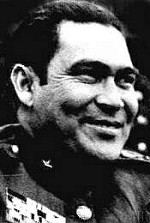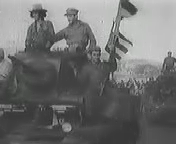Cuban Revolution
|
|
The Cuban Revolution was the overthrow of Cuban dictator Fulgencio Batista by the 26th of July Movement and the establishment of a new government led by Fidel Castro in the 1950s. It began with the assault on the Moncada base on July 26, 1953, and ended on January 1, 1959, when Batista was driven from the country and the cities Santa Clara and Santiago de Cuba were seized by sections of the people's army, led by Che Guevara and Fidel Castro, respectively. The term "Cuban Revolution" is also used to refer to the social revolution from 1959 to present and the adoption of Marxist principles by the new Cuban Government.
This text is about the revolution in the late 1950's, but in Cuba, the word revolution is used for the entire movement towards communism through socialism, thus it is still considered an "ongoing" struggle.
Early Revolution years
On July 26, 1953, a group of 119 rebels attacked the Moncada Barracks in Santiago de Cuba. Many of them were killed in the attack, the survivors, among them Fidel and his brother Raúl Castro were captured shortly afterwards. In a highly political trial, they were sentenced to long prison terms; Castro got 15 years in the presidio modelo located on Isla de Pinos. After the 1955 elections, Batista freed all political prisoners, including the Moncada attackers. The Castro brothers went into exile in Mexico where they gathered more exiled Cubans ready to fight for the Cuban revolution. During that period, Castro also met the Argentinian doctor Che Guevara, who joined their forces. In November 1956, a total of 82 rebels left Mexico onboard the vessel Granma heading for Cuba. All but 12 of them were killed or captured in the first combat immediately after their landing in what was later renamed Granma Province, although there is some dispute about how many survived. Some of the captured guerrillas were extra-judicially executed. Both Fidel and Raúl Castro as well as Che Guevara were among the survivors.
Triumph of the Revolution
In 1958, the troops began their offensive. They advanced in two groups, so called columnas (column). There were four fronts in "Oriente" province (now divided in Santiago de Cuba, Granma, Guantanamo and Holguin) directed by Fidel Castro, Raul Castro and Juan Almeida. The two columns (these were actually two "mobile" fronts) were under the command of Che Guevara and Camilo Cienfuegos and proceeded towards the West and the capital Havana. Camilo won a great and decisive battle in "Yaguajay" earning his nickname "El heroe de Yaguajay"(The Yaguajay Hero). The truly decisive battle of Santa Clara was fought and won by Che Guevara and his unit, this battle is famous for having stopped a train with soldiers and logistic that were destined for Oriente Province troops. When Che and Camilo entered Havana one took over the "Columbia" Military Base (today it is called "Ciudad Libertad (Liberty City) and is an educational city) and "La Cabaña"(today called "morro"). On January 1, 1959, Batista fled to the Dominican Republic. A day later, the rebels occupied both Havana and Santiago. On January 8, Fidel Castro reached Havana, completing the revolution's victory.
Hundreds of Batista regime policemen and soldiers were put on trial for human rights abuses and war crimes, including murder and torture. Most of those convicted of murder (numbering hundreds) were executed by firing squad, and the rest received long prison sentences. Che Guevara was appointed supreme prosecutor in La Cabaña. This was part of a large-scale attempt by Fidel Castro to cleanse the security forces of Batista loyalists that could launch a counter-revolution. Many others were dismissed from the army and police, and some high-ranking officials in the ancien régime were exiled as military attachés. In addition to these measures, the revolutionary government followed a policy of purging all dissidents. This is a policy that remains in place today.
Most of those executed received trials with defence lawyers, witnesses and an attending public (who frequently demanded higher sentences than asked for by prosecutors, and were sometimes quite bloodthirsty). There were also extra-judicial executions, the most notorious being the executions of over 70 captured Batista regime soldiers, directed by Raúl Castro after occupying Santiago.
Castro nationalized all United States and other foreign-owned property in the nation on August 6, 1960; The United States, in turn, responded by placing an embargo on Cuba, which is still in place after more than 40 years.
Many attemps have been made by the Americans to overthrow Castro's rule. One of the most notorious ones is the failure of the Bay of Pigs Invasion. During the Cold War, the U.S. saw Cuba as a strategic location and wanted to invade. But after the Cuban Missile Crisis, it promised to never invade the island.
In July 1961, the Integrated Revolutionary Organizations (ORI) was formed by the merger of Fidel Castro's 26th of July Revolutionary Movement, the People's Socialist Party (the old Communist Party) led by Blas Roca and the Revolutionary Directory March 13th led by Faure Chomón. On March 26, 1962 the ORI became the United Party of the Cuban Socialist Revolution (PURSC) which, in turn, became the Communist Party of Cuba on October 3, 1965 with Castro as First Secretary.
The somewhat dramatized events of the Cuban Revolution played a key role in the plot of the Academy Award winning film The Godfather Part II.
See also
es:Revolución cubana it:Rivoluzione cubana ja:キューバ革命 sk:Kubánska revolúcia fi:Kuuban vallankumous


